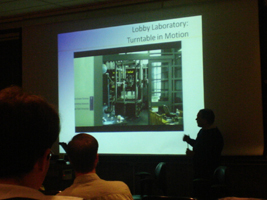Workshop: summary
Day 3: Where to Begin, Where to Go Next
David Holland described the ongoing construction of the Environmntal Fluid Dynamics Laboratory at NYU intended for both research and education. The central piece of equipment is a 1m diameter turntable and PIV system, both acquired commercially.  Some standard experiments (e.g., baroclinic annulus) have been performed successfully. As noted by other lab managers, achieving a perfect lighting condition is a challenge. In addition to the turntable, David installed Environmental Monitoring Stations on the roof of the NYU site, Greenland (Ilulissat Ice Fjord) and Antarctica (Pine Island Glacier) to collect remote data for research purposes and helping students understand the collection process of environmental data. The NYU station is powered by renewable energy and used for teaching sustainability. The data from the remote location is received at the NYU site via satellite.
Some standard experiments (e.g., baroclinic annulus) have been performed successfully. As noted by other lab managers, achieving a perfect lighting condition is a challenge. In addition to the turntable, David installed Environmental Monitoring Stations on the roof of the NYU site, Greenland (Ilulissat Ice Fjord) and Antarctica (Pine Island Glacier) to collect remote data for research purposes and helping students understand the collection process of environmental data. The NYU station is powered by renewable energy and used for teaching sustainability. The data from the remote location is received at the NYU site via satellite.
To many educators, conducting an in-class demonstration or building a laboratory for the first time can be a daunting task. To encourage the beginners, the organizers asked four panelists, Scott Kittelman, Claudia Cenedese, Ruby Krishnamurti, and Juan Botella to offer their insights and engage in dialogs with the audience about their teaching experiences. The questions included how they got interested in experiments, where to seek resources, tips for designing experiments and curriculum around them, and improving delivery and interacting with students. Although some of these questions had been already discussed during the plenary sessions, hearing them from personal perspectives added reality to our perceptions. Most importantly, the panelists' passion for the lab-based teaching was palpable, which was appreciated by all.
During the break, Noboru Nakamura demonstrated his early "proof of concept" model of baroclinic annulus, consisting of a record player, wash basin, cookie cans and a rotating Dove prism (rotoscope).
Based on the program up to this point, John Marshall led the final brainstorming session for future activities. The general sense of the participants was that the meeting of this sort is useful and perhaps we should meet every few years to build a community. The wish list included:
- Details of experiments discussed in the workshop (participants: see our survey).
- TOC or Index search ability to look up for particular experiment
- Technology exchange
- Discussion wiki (coming soon here)
- Clearinghouse of other sites (see the links page as an initial attempt)
- Image bank for common use (clear of legal issues)
- Templates for students evaluation
- List of universities/programs that feature laboratory approaches
- Examples of student-led ideas and experimental designs
We plan to publish a short report on the workshop later this year (BAMS?) but beyond that is uncertain. Identifying a suitable journal for a sepcial section is necessary (JAS? AJP? J Phys. Ed.? J. Math. Geol.?). Also it would be nice to have a volume based largely on images (a la Van Dyke). Your feedback is welcome.
The following University of Chicago students contributed to this summary: Ari Solomon, Mac Cathles, Ian Williams, Samantha Siedlecki, Tinna Jokulsdottir, Ross Ransom. The pictures were taken by students Christina Belanger, Kelly Brunt, and Jennifer Fehrenbacher. Special thanks to student Da Zhu and staff Richard Dahringer & Brian Lynch for technical assistance. Finally, we thank Margarita O'Connell for administrative assistance.